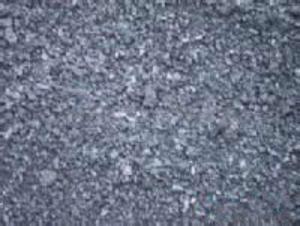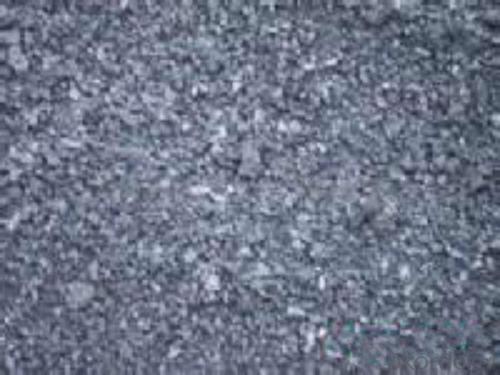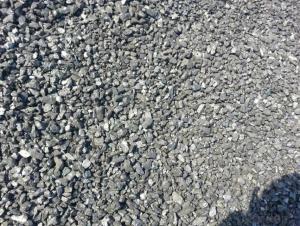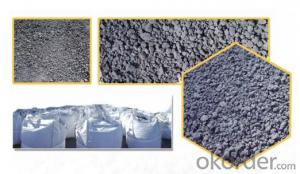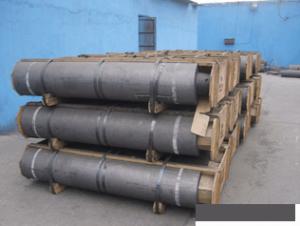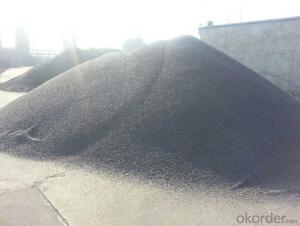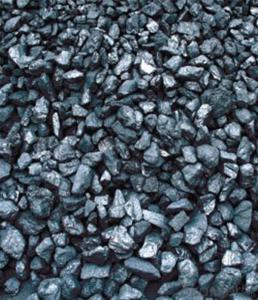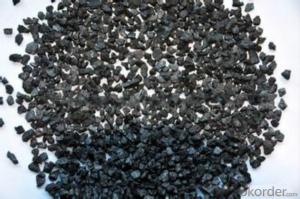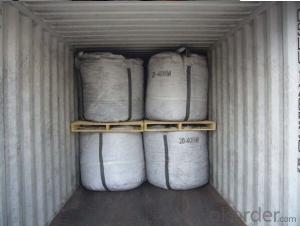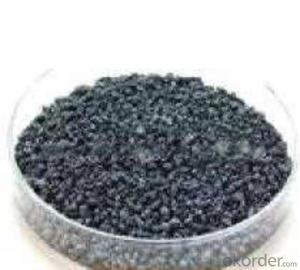FC 90% GCA made in China for steelmaking
- Loading Port:
- Tianjin
- Payment Terms:
- TT OR LC
- Min Order Qty:
- 21.2
- Supply Capability:
- 1012 m.t./month
OKorder Service Pledge
OKorder Financial Service
You Might Also Like
Introduction:
Calcined anthracite can be called carbon additive, carbon raiser, recarburizer, injection coke, charging coke, gas calcined anthracite.It is playing more and more important role in the industry
Best quality Anthracite as raw materials through high temperature calcined at over 2000℃ by the DC electric calciner with results in eliminating the moisture and volatile matter from Anthracite efficiently, improving the density and the electric conductivity and strengthening the mechanical strength and anti-oxidation. It has good characteristics with low ash, low resistivity, low sulphur, high carbon and high density. It is the best material for high quality carbon products. It is used as carbon additive in steel industry or fuel.
Features:
G-High Calcined Anthracite is produced when Anthracite is calcined under the temperature of 1240°C in vertical shaft furnaces. G-High Calcined Anthracite is mainly used in electric steel ovens, water filtering, rust removal in shipbuilding and production of carbon material. We are serving the clients from the world
Specifications:
F.C.% | 95MIN | 94MIN | 93MIN | 92MIN | 90MIN | 85MIN | 84MIN |
ASH % | 4MAX | 5MAX | 6 MAX | 6.5MAX | 8.5MAX | 12MAX | 13MAX |
V.M.% | 1 MAX | 1MAX | 1.0MAX | 1.5MAX | 1.5MAX | 3 MAX | 3 MAX |
SULFUR % | 0.3MAX | 0.3MAX | 0.3MAX | 0.35MAX | 0.35MAX | 0.5MAX | 0.5MAX |
MOISTURE % | 0.5MAX | 0.5MAX | 0.5MAX | 0.5MAX | 0.5MAX | 1MAX | 1MAX |
Pictures
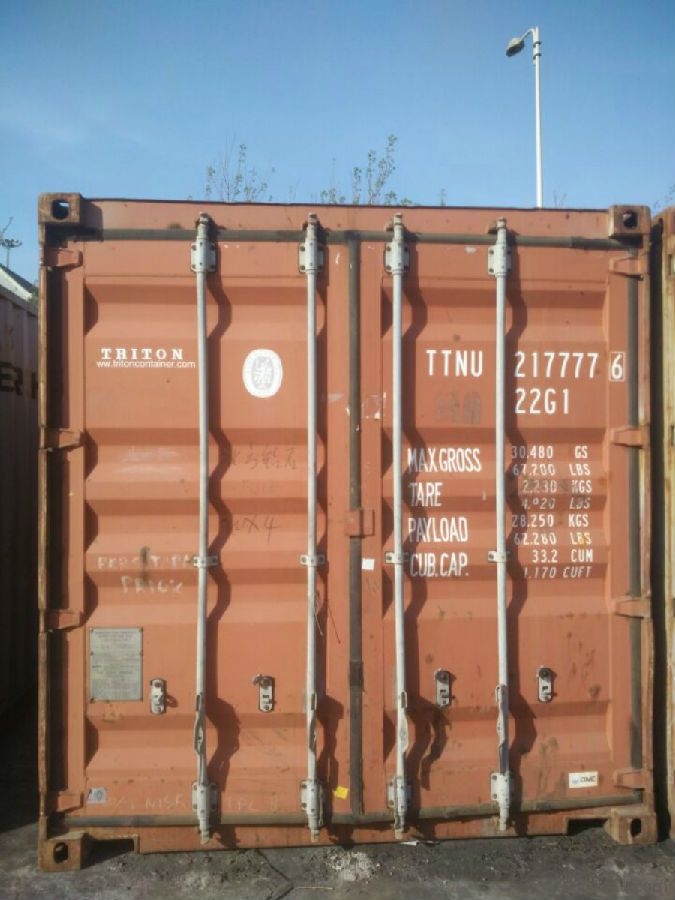
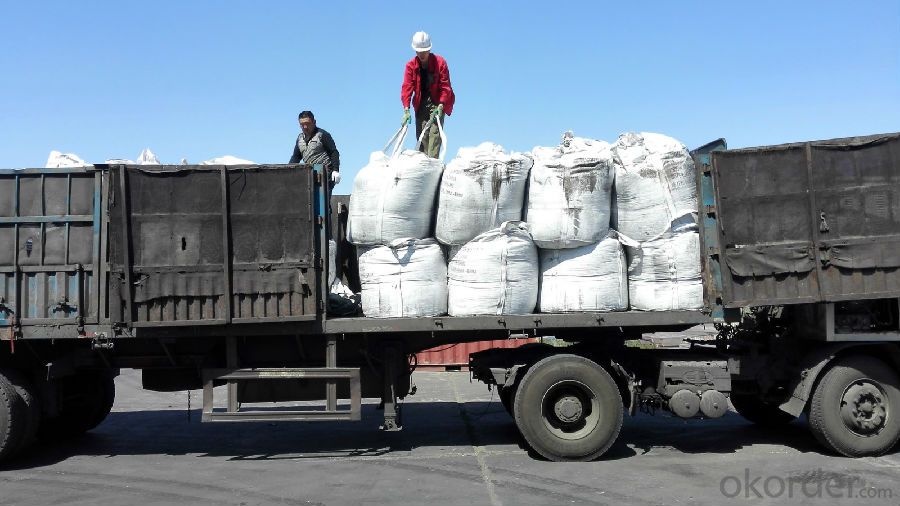
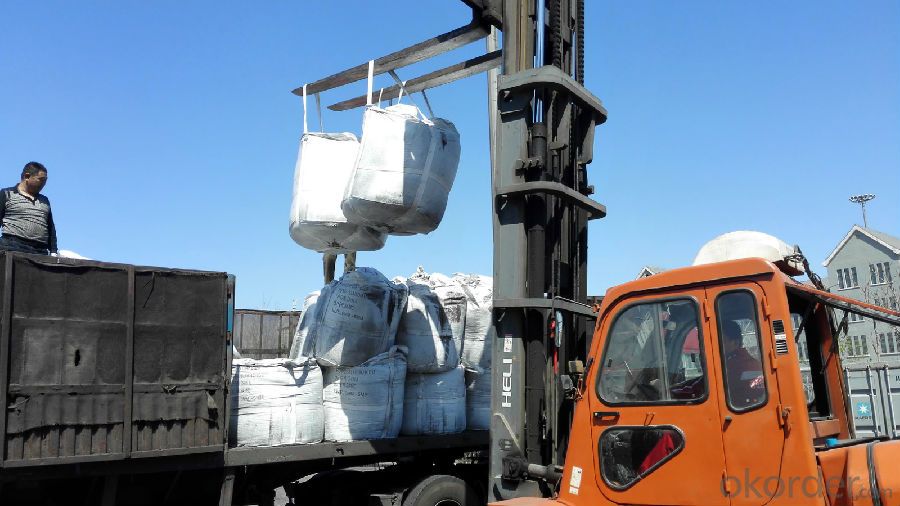
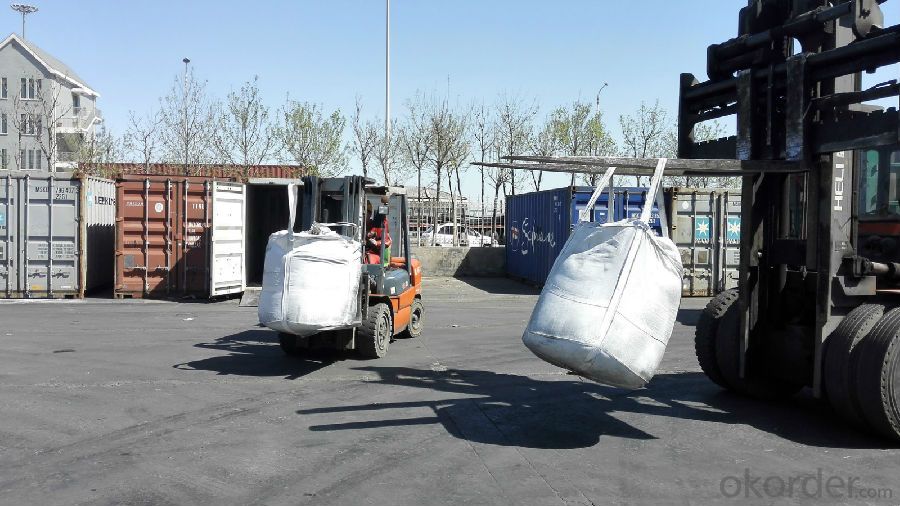
FAQ:
Packing:
(1). Waterproof jumbo bags: 800kgs~1100kgs/ bag according to different grain sizes;
(2). Waterproof PP woven bags / Paper bags: 5kg / 7.5kg / 12.5kg / 20kg / 25kg / 30kg / 50kg small bags;
(3). Small bags into jumbo bags: waterproof PP woven bags / paper bags in 800kg ~1100kg jumbo bags.
Payment terms
20% down payment and 80% against copy of B/L.
Workable LC at sight,
- Q: How is carbon formed?
- Various natural processes contribute to the formation of carbon, primarily the life and death cycle of living organisms. The process of photosynthesis in plants initiates carbon formation, as they utilize sunlight, water, and atmospheric carbon dioxide to produce glucose. This glucose is then transformed into other organic compounds, including carbohydrates, fats, and proteins, which are the fundamental constituents of all living beings. When plants and animals perish, decomposers like fungi and bacteria break down their remains and waste materials. During this decomposition, carbon is released back into the environment in the form of carbon dioxide or methane gas. Additionally, some organic matter may become buried beneath sediment layers, where it undergoes fossilization over millions of years. Through a combination of heat and pressure, this fossilization process converts the organic matter into fossil fuels like coal, oil, and natural gas, which are abundant sources of carbon. In addition to biological processes, carbon can also form through geological processes. Volcanic eruptions discharge carbon dioxide into the atmosphere, and over extended periods, this carbon dioxide can dissolve in water and react with minerals to create rocks like limestone. These rocks function as carbon sinks, storing substantial amounts of carbon over geological timescales. In general, the formation and cycling of carbon involve a complex interaction between biological and geological processes, significantly contributing to the equilibrium of carbon in the Earth's atmosphere and supporting life as we currently understand it.
- Q: What are the effects of ocean acidification on marine life?
- Ocean acidification is a significant issue that poses numerous detrimental effects on marine life. The primary cause of this phenomenon is the increase in carbon dioxide (CO2) emissions, which are absorbed by the oceans, leading to a decrease in pH levels. As the ocean becomes more acidic, it has profound consequences for various marine organisms and ecosystems. One of the most vulnerable groups impacted by ocean acidification is shell-forming organisms, such as corals, mollusks, and some types of plankton. The increasing acidity reduces the availability of carbonate ions, a vital component for these organisms to build and maintain their shells or skeletons. As a result, their growth and development are hindered, making them more susceptible to predation and extinction. This not only affects these individual species but also disrupts the entire food web, as they serve as a crucial food source for many other marine organisms. Furthermore, ocean acidification has adverse effects on various marine organisms' physiology and behavior. Studies have shown that it can impair the ability of fish to detect predators, find food, and navigate, which can lead to reduced survival rates and altered migratory patterns. Additionally, acidification can disrupt reproductive processes, such as the growth and survival of fish larvae, leading to population declines and reduced biodiversity. Coral reefs, often referred to as the "rainforests of the sea," are particularly vulnerable to ocean acidification. The increased acidity inhibits the calcification process essential for coral growth, making them more susceptible to bleaching and death. As coral reefs provide crucial habitats for numerous marine species, their decline would have cascading effects on the entire ecosystem. Lastly, ocean acidification also impacts the balance of marine ecosystems by altering the composition and abundance of various species. Some organisms, such as certain types of algae, may actually benefit from increased CO2 levels and thrive, leading to an imbalance in the ecosystem. This can result in the dominance of certain species, negatively impacting the overall biodiversity and stability of the marine environment. In conclusion, ocean acidification poses significant threats to marine life. It disrupts the growth and development of shell-forming organisms, impairs the physiology and behavior of various marine species, damages coral reefs, and alters the composition of marine ecosystems. Addressing this issue is crucial to protect marine biodiversity, sustain fisheries, and maintain the overall health of our oceans.
- Q: What are the effects of carbon emissions on the Earth's temperature?
- Carbon emissions, particularly carbon dioxide (CO2), have a significant impact on the Earth's temperature through the greenhouse effect. The greenhouse effect refers to the process by which certain gases in the Earth's atmosphere trap heat from the sun and prevent it from escaping back into space, thus warming the planet. When carbon emissions are released into the atmosphere, they act as a blanket, trapping more heat and exacerbating the greenhouse effect. This leads to an increase in global temperatures, commonly known as global warming. The primary source of carbon emissions is the burning of fossil fuels such as coal, oil, and natural gas for energy production, transportation, and industrial processes. The accumulation of carbon dioxide and other greenhouse gases in the atmosphere has resulted in a steady increase in global temperatures over the past century. This rise in temperature has numerous consequences for the Earth's climate system and ecosystems. One of the most immediate impacts of increased carbon emissions and global warming is the melting of polar ice caps and glaciers. As temperatures rise, ice melts at an accelerated rate, contributing to rising sea levels. This poses a significant threat to coastal areas, where increased flooding and erosion can occur, leading to the displacement of communities and loss of habitats for various species. Additionally, global warming disrupts weather patterns, leading to more frequent and intense extreme weather events. Heatwaves, droughts, hurricanes, and heavy rainfall events become more common, causing damage to infrastructure, agriculture, and human health. Changes in precipitation patterns also affect water availability and can lead to water scarcity in certain regions. The Earth's temperature directly influences ecosystems and biodiversity. Many species are highly sensitive to even small changes in temperature, which can disrupt their natural habitats, alter migration patterns, and impact reproductive cycles. These changes can ultimately lead to the extinction of certain species and disrupt entire ecosystems. Furthermore, the warming of the Earth's temperature can have cascading effects on various natural processes. For example, it can lead to the release of additional greenhouse gases from melting permafrost and the degradation of forests, further exacerbating global warming. In conclusion, the effects of carbon emissions on the Earth's temperature are profound and wide-ranging. Global warming caused by increased carbon dioxide levels leads to melting ice caps, rising sea levels, extreme weather events, disruptions to ecosystems, and potential loss of biodiversity. Addressing carbon emissions and working towards sustainable practices are crucial in mitigating these effects and ensuring a stable and habitable planet for future generations.
- Q: How is carbon used in the production of fuel cells?
- Fuel cells utilize carbon in various ways during their production. The construction of electrodes is one of the primary applications of carbon in fuel cells. These electrodes, which consist of an anode and a cathode, are commonly made from carbon-based materials like graphite or carbon paper. These materials enable the electrochemical reactions within the fuel cell to occur by offering a conductive surface. Furthermore, carbon serves as a catalyst in fuel cells. Catalysts are substances that accelerate chemical reactions without being consumed in the process. Carbon-based catalysts, such as platinum or palladium, are frequently employed in fuel cells to facilitate the reactions that generate electricity. These catalysts enhance the efficiency of fuel-to-electricity conversion. Moreover, carbon is employed in the form of carbon nanotubes during fuel cell production. Carbon nanotubes exhibit unique properties such as high surface area and exceptional electrical conductivity, making them ideal for enhancing fuel cell performance. By providing a larger surface area for reactions to occur on, carbon nanotubes can improve the efficiency of fuel cell reactions. In summary, carbon plays a vital role in fuel cell production by providing the necessary materials for electrode construction, acting as catalysts for electrochemical reactions, and enhancing fuel cell performance through the utilization of carbon nanotubes.
- Q: How does carbon impact the prevalence of tropical storms?
- Carbon has a significant impact on the prevalence of tropical storms as it contributes to the warming of the Earth's atmosphere. Increased carbon emissions from human activities, such as burning fossil fuels and deforestation, lead to a rise in global temperatures, which in turn fuels the intensity and frequency of tropical storms. The warmer air holds more moisture, resulting in increased rainfall and the potential for stronger hurricanes. Additionally, carbon-induced climate change can alter atmospheric circulation patterns, creating favorable conditions for the formation and intensification of tropical storms. Thus, reducing carbon emissions is crucial to mitigate the impacts of climate change and potentially lessen the prevalence of tropical storms.
- Q: How does carbon impact the stability of savannah ecosystems?
- The stability of savannah ecosystems relies heavily on carbon, which is crucial for all living organisms and involved in various ecological processes. Carbon exists primarily in the form of organic matter, which is vital for the growth and development of plants, the primary producers in these ecosystems. In savannahs, carbon affects stability in multiple ways. Firstly, carbon dioxide (CO2) plays a significant role in regulating the global climate as a key component of the Earth's atmosphere. Savannahs have the ability to sequester and store large amounts of carbon in their vegetation and soils, thereby mitigating climate change by reducing CO2 levels in the atmosphere. Carbon is also essential for plant growth through photosynthesis. Savannah plants, like grasses and scattered trees, utilize carbon dioxide from the air to produce carbohydrates and other organic compounds. This process not only provides plants with energy but also contributes to the overall productivity of the ecosystem. The stability of savannah ecosystems is also dependent on the interaction between plants and animals. Carbon-rich vegetation serves as a food source for herbivores, which in turn support predators. The carbon cycle ensures a continuous flow of energy and nutrients throughout the food web, maintaining ecosystem balance and stability. Moreover, the carbon content in savannah soils affects their fertility and ability to retain moisture. Organic matter derived from decaying plant material improves soil structure, nutrient availability, and water holding capacity. This, in turn, supports vegetation growth and sustains the diverse array of species found in savannah ecosystems. However, human activities such as deforestation, agricultural practices, and the burning of fossil fuels are disrupting the carbon balance in savannahs. Deforestation removes carbon-rich trees and plants, reducing the overall carbon storage capacity of the ecosystem. Additionally, the release of carbon dioxide from burning fossil fuels contributes to the greenhouse effect and climate change, which can disrupt savannah ecosystem stability. In conclusion, carbon plays a critical role in maintaining the stability of savannah ecosystems. It influences climate regulation, supports plant growth, provides energy for the food web, and enhances soil fertility. However, human activities that disrupt the carbon balance in these ecosystems can have detrimental effects on their stability and overall health. Therefore, it is essential to conserve and restore savannah ecosystems to preserve their carbon storage capacity and ensure long-term stability.
- Q: Is aluminum alloy expensive or high carbon steel expensive?
- Aluminum must be expensive, carbon steel is rubbish
- Q: What are the applications of carbon nanowires?
- Carbon nanowires have numerous applications in various fields. They are used in electronics for creating high-performance transistors, sensors, and conductive electrodes. Their exceptional mechanical properties make them suitable for reinforcement materials in composites, such as lightweight and strong materials for aerospace and automotive industries. Carbon nanowires also find applications in energy storage devices like batteries and supercapacitors, as well as in biomedical engineering for drug delivery systems and tissue engineering scaffolds.
- Q: What are the problems that should be paid attention to in the injection molding of the material? Who has some details about carbon fiber injection? Thank you for sharing
- You can go directly to the Chinese HowNet or the census, there should be some.
- Q: What is carbon monoxide poisoning?
- Carbon monoxide poisoning is a potentially life-threatening condition that occurs when a person inhales excessive amounts of carbon monoxide gas. This gas is colorless, odorless, and tasteless, making it difficult to detect without proper monitoring equipment. When inhaled, carbon monoxide displaces oxygen in the bloodstream, leading to oxygen deprivation to vital organs and tissues. Symptoms can range from mild headache and nausea to dizziness, confusion, and even death. It is crucial to have working carbon monoxide detectors in homes and to seek immediate medical attention if poisoning is suspected.
Send your message to us
FC 90% GCA made in China for steelmaking
- Loading Port:
- Tianjin
- Payment Terms:
- TT OR LC
- Min Order Qty:
- 21.2
- Supply Capability:
- 1012 m.t./month
OKorder Service Pledge
OKorder Financial Service
Similar products
Hot products
Hot Searches
